Media | Articles
The Exhaust Problem (Part 1)
As I wrote last week, I bought a 2008 Nissan Armada to have as a keep-it-in-the-driveway-until-you-need-it tow vehicle/stuff-hauler/snowmageddon chariot. At $3250, it was cheap, but a few problems were baked into that price, one of which was a leaky exhaust that wasn’t loud enough for me to hear but was apparent when I held my gloved hand over the tailpipe.
A tight exhaust should pretty much push your gloved hand off, but one with substantial leaks one won’t offer any resistance at all. So I bought it knowing it needed exhaust work. The question was, how much? The tried-and-true triage method is to visually examine the entire length of the exhaust as well as block off the tailpipe with a cut-off inner tube and a hose clamp and carefully run your hands close to all exhaust surfaces to feel for leaks, but I was unable to do either of those things on the seller’s muddy dirt-and-gravel driveway.
Let’s put on our rose-colored glasses for a moment. Back in the golden pre-emission-control days, most exhaust systems consisted of a cast-iron exhaust manifold that likely lasted the life of the car, and four normal-wear-and-tear components—the headpipe that bolted to the manifold, the center resonator, the muffler, and possibly a separate tailpipe. These components were interconnected by flanges sealed by either gaskets or crush rings, and held together with simple nuts and bolts. Replacing isolated sections was usually easy. If the exhaust got loud, you crawled under the car, figured out which section was rotted out, bought another one, installed it—boom, done. Yeah, OK, some exhaust sections were fitted by sliding one tube inside another and U-clamping them together, and over time, rust would fuse the sections making replacement difficult, but if you were careful you could usually manage it.
As vintage cars age, though, it’s common for them reach the point where, if one component is rusted through, the smart thing is to “just do it all” and replace the entire exhaust, meaning everything except the manifold. The reason is twofold. First, if one exhaust component is rusty enough to be ventilated, odds are that the others aren’t far behind. Second, it’s often challenging to get new components to seal against old ones. Some of this is unevenness on the sealing surface of the old component, some is that the flange size on a non-original replacement component is subtly different from that which it needs to mate with in the car. If it’s a car you’re keeping for the long term, buying and installing a new exhaust—be it original (if it’s still available), aftermarket, performance, stainless steel, or whatever—is often a good box to check off for a rejuvenation.
The other option is to go to a custom exhaust shop where they measure, bend, and install a system specifically for your car. I’m generally not a fan of this approach, as custom exhausts often have welded joints that make it difficult or impossible to drop the exhaust to, for example, remove a transmission. I had it done a few years ago in my little Winnebago Rialta RV because there was no other option.
Marketplace
Buy and sell classics with confidence
Things became more complicated when catalytic converters crept in in the mid-1970s, as the cat was an expensive additional component that could rust out and get loud, and it had an extra set of flanges that needed to seal to make the exhaust tight. V-configuration engines typically have a separate cat for each bank of cylinders. And many cars, including the Armada, are equipped with primary and secondary cats on each bank, for a total of four. This creates six flange joints where the cats can leak (manifold to primary, primary to secondary, secondary to the rest of the exhaust, on each side).
You can see why “just do it all” is not ever my go-to strategy on a modern car. It’s simply too expensive. If an exhaust and one or more cats needs to be replaced in a high-mileage 15-year-old car, the dealer estimate for the repair can easily exceed the car’s value, and the price from an aftermarket or custom shop can easily top a thousand dollars.
So, with that backdrop, let’s look at the Armada. The exhaust was porous enough that a rubber glove clamped over the tailpipe was enough to redirect all the flow through the holes, making them easier to find.
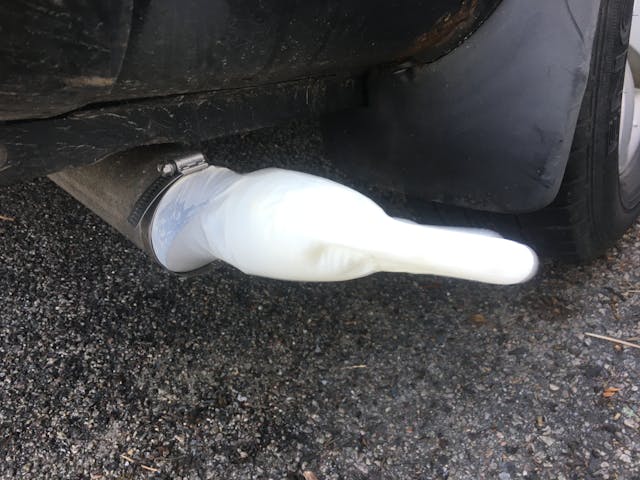
The Armada doesn’t have the ground clearance that my Silverado 3500HD did (which enabled its catalytic converter to get stolen, but also allowed me to replace it without lifting the truck), but the rear section of the exhaust is pretty accessible. I skooched under the back and quickly found a major leak where the tailpipe was attached to the muffler with the world’s worst weld. I bought a decent mig welder about five years ago but have never walked up the learning curve to use it properly, and I’m certain that if I attempted to re-weld the joint, it would look no better. I’ve certainly done my share of soup-can-and-hose-clamp exhaust repairs and tested one here with aluminum flashing, but the big bulge from the misaligned pipes and the weld didn’t give it a hope of sealing.
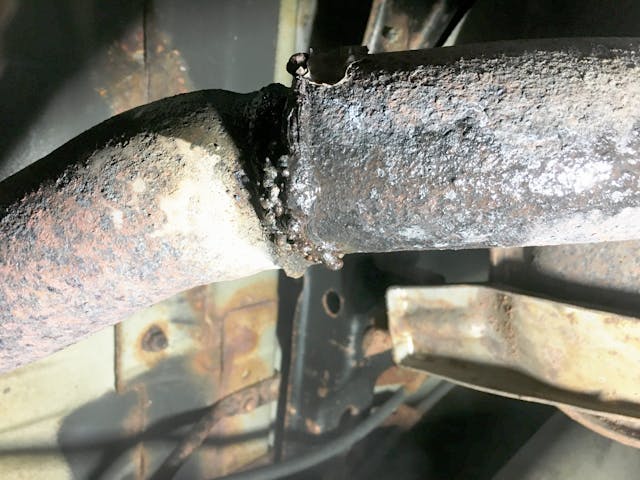
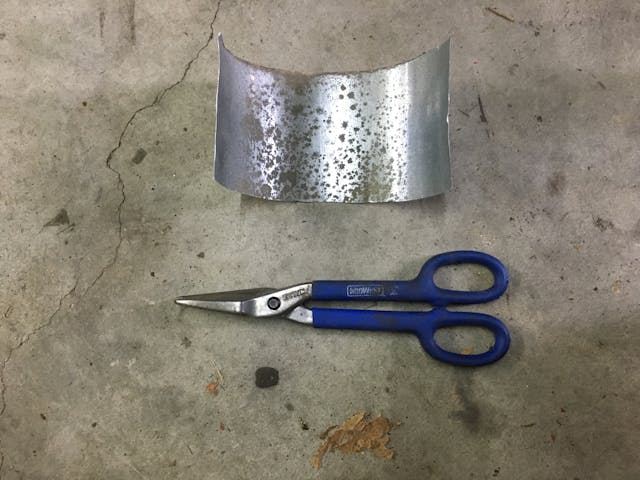
I’ve occasionally used a local exhaust shop to patch isolated leaks like this, so I took the Armada to them for a quote on fixing the tailpipe, thinking that maybe all it needed was a hundred-dollar splice-and-weld. Unfortunately—and not surprisingly—when they had it on the lift and inspected it, they found that the tailpipe was only one of three leaks. There was also a good-sized leak from the seam on the top of the muffler, and a small leak at the output flange of the right rear (secondary) catalytic converter. Unfortunately, the studs and nuts on that flange were decimated by rust, and the flange itself looked paper-thin. The shop’s recommendation was to cut off the flange and weld a new pipe from the back of the cat to a new muffler and tailpipe. The $1200 estimate wasn’t unreasonable, but it was more than I wanted to spend.

I thought about my options, all of which were limited by winter weather and my workspace. The Armada is big enough that, to fit it in my garage, I’d need to kick not one car outside, but two. That’s fine when the weather’s good, but I’m not going to let my 49,000-mile 1973 BMW 2002 sit outside in rain or snow, and due to the configuration of my narrow suburban driveway, which is hemmed in by my house and my neighbor’s high fence, when we get a lot of snow, there’s nowhere to blow it, so the garage can get snowed in for weeks.
So I tried the easiest path first—muffler paste. This stuff comes in a couple of forms. There’s muffler cement that’s intended to fill gaps and seal joints, and there’s muffler putty that’s intended to be more structural. I had a can of the latter in the garage, so I gave both the tailpipe and the top of the muffler a wire-brushing, then with a nitrile glove on my hand, shoveled the putty into and around the tailpipe weld and into the seam on the top of the muffler.
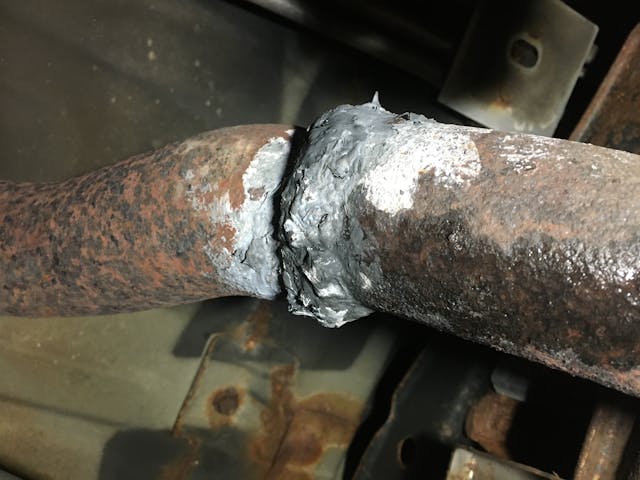
At this point, I need to explain a few things about Massachusetts’ draconian annual automotive inspection. I love my home state, but not this part of it. You’re required to have a vehicle inspected within seven days of purchase. It doesn’t matter if it already has a valid inspection sticker on the windshield. That’s not your sticker—it’s the previous owner’s. The sticker has the car’s plate number and VIN printed on it in small type, and a bar code that a police officer can scan and call up the registration. So if you’re driving on the old sticker, and you’re stopped for some reason and the officer checks the sticker, you’ll be cited for driving an uninspected vehicle, which is a moving violation that adds points to your license. There are rare reports of people even being ticketed for this when the car is parked. Plus, there is the safety part of the inspection and the emissions part. If you fail the emission part, you get a black “R” sticker with a 60-day grace period for you to get the car repaired, but if you fail for a safety reason, you get a red “R” sticker with no grace period—you can be pulled over any time and ticketed—and an exhaust leak is regarded as a safety issue. I’m uncertain exactly how they check for exhaust leaks, whether they do the hand-over-the-tailpipe test on every single car or only on cars that have loud-sounding exhausts.
So. I’d bought the Armada with a leaky but largely asymptomatic exhaust. The inspection sticker on the car was good through August, but it wasn’t my sticker. Legally I was required to get the beast inspected, but … should I? The risk was that it would fail and I’d lose the valid-looking sticker, be given a big red rejection sticker that’s far more visible (moving violation-wise), and have to spend real money replacing the exhaust.
I thought it over. The exhaust didn’t sound loud to me to begin with, and I’d patched the two big leaks, so it had to be quieter and better-sealed than before. Do it. Get it inspected. Cross it off the list. Be legal about it, as I am with most things these days. I brought it in.
Bad idea. It failed. I’d rolled the dice and lost. The car I’d bought to have around in case I needed to drop everything and buy something big now had a large red “R” on the windshield that could land me an expensive ticket.
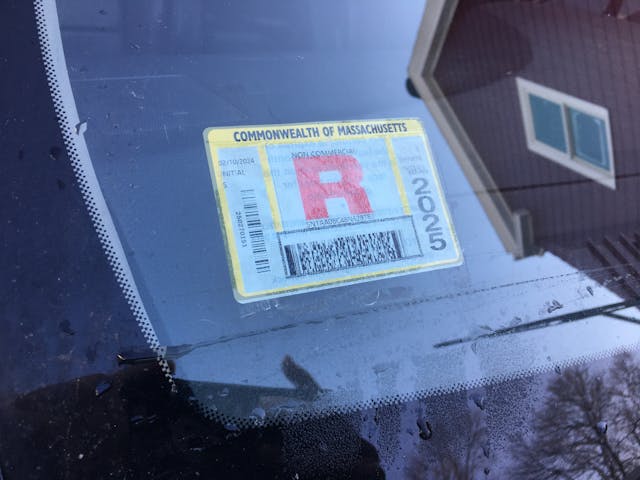
To make matters worse, a winter nor’easter was forecast to move in and dump 8–12 inches of snow, effectively cutting off access to my garage. And the logistics of major exhaust surgery on the Armada were daunting, as the vehicle’s weight is uncomfortably close to the 6000-pound limit of my mid-rise lift. I’d likely need to do the whole thing on the garage floor, which, at age 65 with back issues, didn’t sound like a lot of fun.
I still do essentially all my own work, but I realize that there are times when you need to, as they say, just pay the man (or woman). Was this one of those times? I wasn’t sure. It drives me crazy when I’m put in a situation where I need to pay someone 10 times what it would cost for me to do something myself.
I looked on RockAuto (you gotta love RockAuto) and found that there are several well-priced aftermarket cat-back exhausts available for the Armada, two of which are less than $200 shipped to my house. The question was the slippery slope of that secondary catalytic converter’s paper-thin rear-facing flange. Since I don’t weld, if that flange broke or wouldn’t seal, I’d need to replace that cat. I wanted to know what the cat’s front flange looked like (where it mates with the primary cat), but I couldn’t get under the car, so I stuffed my phone under and shot some pics. What I saw was concerning. The idea of a minor exhaust repair potentially cascading into replacing two catalytic converters made me want to consider my next steps very carefully.
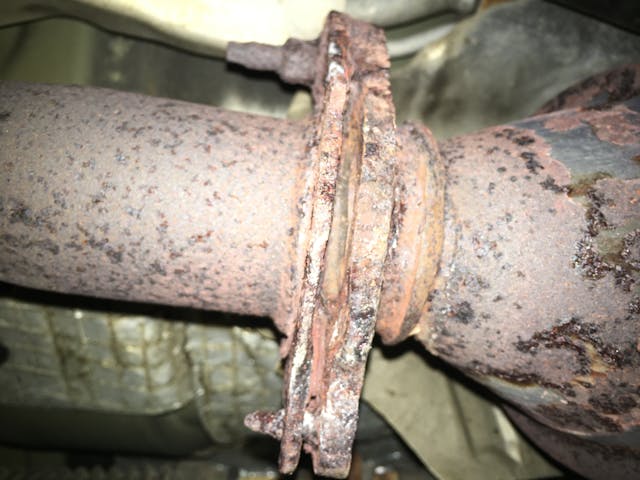
What’s a Hack Mechanic to do? Tune in next week in find out.
***
Rob’s latest book, The Best Of The Hack Mechanic™: 35 years of hacks, kluges, and assorted automotive mayhem is available on Amazon here. His other seven books are available here on Amazon, or you can order personally-inscribed copies from Rob’s website, www.robsiegel.com.
Check out the Hagerty Media homepage so you don’t miss a single story, or better yet, bookmark it. To get our best stories delivered right to your inbox, subscribe to our newsletters.
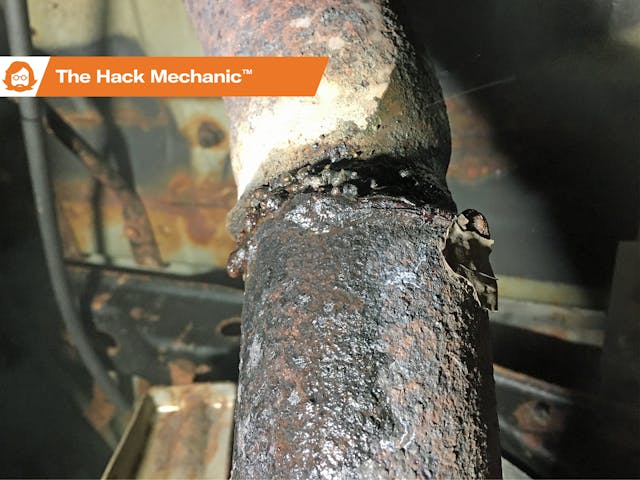









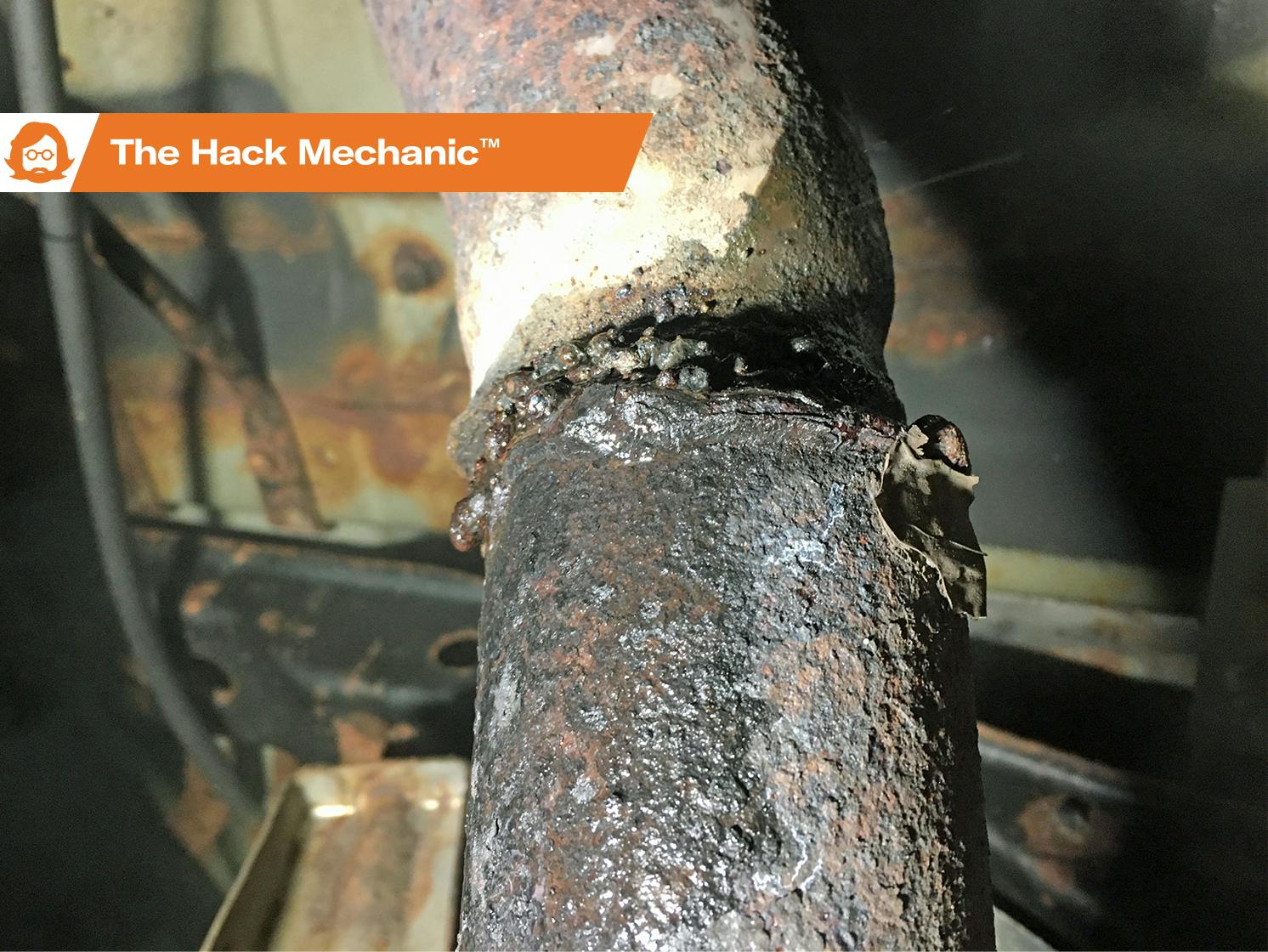
I am afraid this is only the beginning of a downward spiral. You know like when a B17 in a old war video loses a wing.
There are cheap cars for a price. Often the price of these patches can get expensive over time and repeated occurrences. Often they are why people dumped these models to start.
The benefit of old American trucks is that they used to be cheap to buy but the parts are still cheap and easy to find used and new. The aftermarket makes it so easy to repair them with the many available parts.
Having a somewhat rare SUV is not going to go well.
I really wonder about the exhaust. I have had cars since the 80’s and never had to replace an exhaust. The stainless holds up well. Even my 1985 Pontiac is stainless from manifolds to tail pipe and still on the car like new. I am shocked for so much rust.
I just found there is a problem on Subaru Foresters that have a flex pipe in their system. 3-5 years it is breaking and around $4K to repair at a dealer. In California these pipes are covered up to 15 years 150K miles but else where SOL.
When buying a used car get it on a lift and look at it well. I wager this Nissan may also have bending brake line issues and possible unibody issues just waiting to break.
A lift saved me from an El Camino that had a hole the side of my fist in the frame. It had a new paint job and interior but they missed the frame.
Back in the day, a six-pack and a ten-spot would find somebody in a ‘service’ station to run a car up on the lift for 20 minutes. Remember service stations?
I also remember back in they day (1060’s mostly) we’d have some junky farm vehicle we’d stick some S&H green stamps in the corner of the windshield and hope to not get pulled over going into town .
-Nate
I remember yearly inspections. Shake down is more correct.
I don’t know how you folks can tolerate that.
I’m in the middle of a project to rebuild the exhaust in a 20+ year old Dodge truck here in PA. A friend of mine with a CNC plasma machine cut me some flanges which I am welding on the exhaust. I hate welding under the truck and only do it when i have to. There is just no way to reach all the pipe so there will always be a leak. With the flanges, I can take the exhaust out in sections for repair or replacement if need be. And my welds are all solid since I can bench weld everything.
The secret to using the paste/cement is a piece of stainless steel mesh. Pre-form it and leave several strands long so that when you wrap the pipe you can lock it together. Smear the Permatex cement on first, wrap it with the mesh, then coat a second time. I had this on the exhaust for easily 5k miles before I had to replace it for separating at the muffler. It also passed MA inspection…..
So…what then is the point of inspection?
I’m all for frugality, but come on, just replace the exhaust.
This story reinforced my belief that there is nothing more expensive than a bargain vehicle. Let me ask you something, Rob: Do you really need this thing? How often, really, do you need to tow? I ditched my pickup a couple years ago and found I haven’t missed it. If I should ever need to tow something, I’ll just rent a pickup and trailer. The case for what amounts to a rarely-used driveway ornament seems uncompelling to me.
I think we’ve all just got our own different brand of brain damage. This story kind of did the opposite for me. Once he fixes the exhaust leaks, struts, and some other minor stuff, he’ll have a vehicle that he’ll enjoy even if only for a year or two before flipping it and getting something else for that slot. My brain damage is that I love bargain vehicles, and my level of enjoyment I get out of one is inversely proportional to the amount of money I have tied up in it. I don’t feel like he’s hurting at all yet with what the Armada needs to become a dependable driver.
Terry, I went through this in several other pieces. It made sense for me to sell my big Silverado HD3500 because I wasn’t really using it, but as soon as it was gone, I missed having it. On paper, I don’t have a big need for a big vehicle, but I felt that my style was being crimped without it. For short money (and long work), I can have one.
I reached the same conclusion with my just-sold Suburban. It had new premium tires when I bought it 12 years ago, but they aged out, of course. 3,000 miles of towing – about six trips with the trailer. Insurance cost alone would have rented a pick-up once or twice each year.
Rob, are you allowed to use flange repair kits and pipe adapters, as long as it is sealed to pass inspection? Perhaps weld repairing sections on a work bench and install with clamps to avoid having to weld while under the vehicle. A handy tool to check for exhaust, vacuum leaks and more is a smoke tester.
Vehicle is old enough that it doesn’t have to go through emissions inspection.
One of my best shop investments was a 110V mig welder
I also have the fortune to live in a state where all they care about is emissions, and does not inspect anything older than 1995. When they did, they had a camera in the inspection lane that displays the underside of the car on a monitor. It’s still there, but I think the only thing they use it for now is to make sure you actually have cats installed
Rob: $1200 is a tough pill to swallow, but having it done, and done correctly, is peace of mind.
You and I are the same age, and, with the exception of my Boxster, which really doesn’t have an exhaust “system” (the muffler bolts to the cats and dumps directly out the back), I have not touched an exhaust system in over 20 years. The whole Rust Flakes In The Eyes thing just doesn’t work any longer.
FWIW
Looking at those catalytic flanges, I feel they can be saved. The worst part is you’d have to knock out what’s left of the studs and replace them with bolts.
The magnitude of RockAuto magnets on my toolbox would say that I agree with them as an excellent supplier. The fact that they pre-pay all border fees also makes ordering for this Canadian pretty painless.
Here’s a tip I found from YT for finding exhaust leaks.
Take your shop vac, reverse the flow to blow instead of suck, and hook it to the tailpipe sealing with duct tape if needed.
This is especially useful because you can test the system cold preventing burns and generally leaks are worse when cold.
Bill, I had heard that you shouldn’t apply back pressure to CATs, that it can somehow damage them. If the pressure from a shop vac isn’t enough to do any damage, then this is a great alternative to running the car and getting burned while checking for leaks. Does anyone know if CATs can be damaged this way?
Excellent!
I discovered this trick a few years ago myself. I used to find some exhaust leaks in my old header gaskets that I was sure were indicative of valve train noise on my small block Ford. I ended up replacing the header gaskets after I found the leaks with the shop vac – noise problem solved.
Living in Wisconsin this is the norm for vehicles even 6 to 7 years old. Maybe try a clam shell style exhaust clamp. It’s an exhaust flange that comes in 2 pieces that way if fits around the pipe with no welding. I have had success with these when whole exhaust system replacement isn’t feasible. This might be the trick for just replacing from the cat back. just a thought.
For the rusted flanges, leave them there. Get 2 split exhaust flanges and place them 90 degrees to the existing flanges. Tighten the bolts and they’ll likely reseal the existing leaky flange.
Rob: Just get a black sharpie and change the red R to a black R on the safety sticker. This may have to be done on the surface of the windshield depending how the sticker is applied. All though illegal I did make my own safety sticker when I was 45 years younger and in college as an art student, using water colors and sharpies, it worked until I could get my VW bug fixed.
Really Rob, this is a no brainer. Get some books on welding. Practice on some exhaust pieces.
Tune in tomorrow, same bat-time, same bat-channel!
I have a 110V Mig welder, too. I bought our ’08 Hemi Ram new and it now has 192,000 miles. Just backed into a rock and cracked the exhaust in 3 or 4 places. I bought a chunk of 3″ stainless for $30 on FB MP, removed the whole exhaust from the y pipe back, welded some new pieces of pipe in and also patched a few holes in the muffler, then re-assembled. I figure it should be good for another 50K miles. I hate doing exhaust work, but it’s really not bad at all if you can take the whole thing out. I also really like those stainless V band clamps. Use those and it becomes much easier to drop the whole exhaust and re-assemble and align things.